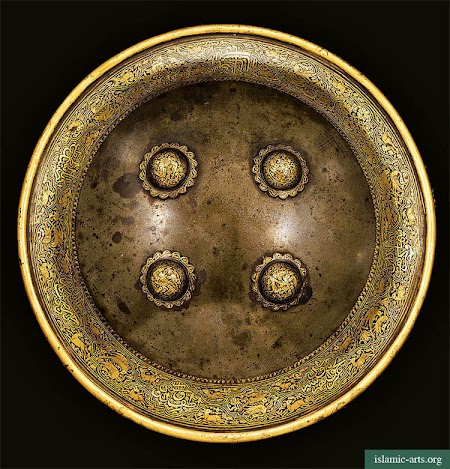 |
| A GOLD-OVERLAID WATERED-STEEL SHIELD, PERSIA, EARLY 19TH CENTURY |
of domed circular form with four
applied bosses with gold overlaid decoration at the outer ring,
comprising wholly of cusped cartouches filled with animal motifs and inscriptions, the textile-padded interior with four suspension loops.
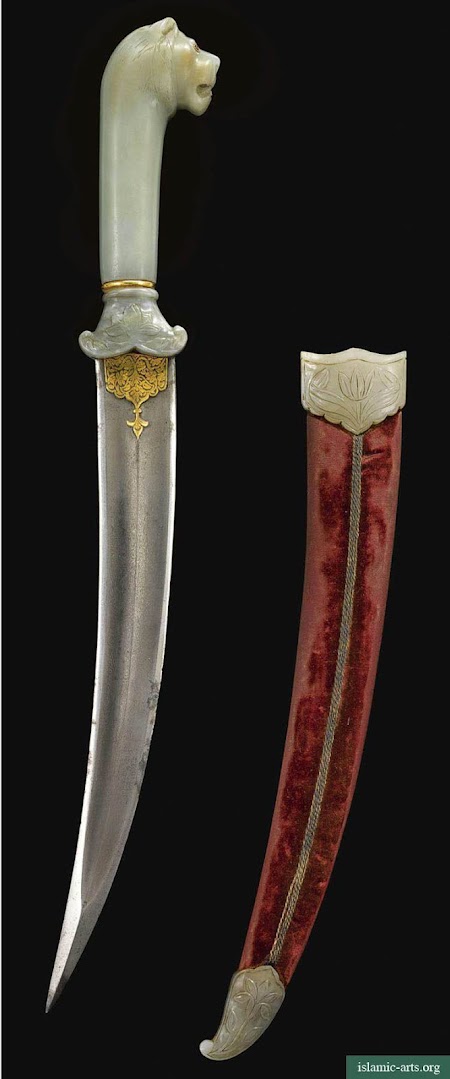
- A MUGHAL GEM-SET JADE-HILTED DAGGER, INDIA, CIRCA 1700, AND JADE-MOUNTED SCABBARD, 19TH CENTURY
The slightly curved watered-steel
blade with central ridge and double grooves, gold-overlaid palmette and
cartouche at forte, the jade hilt with scroll quillons and carved
stylised lotus leaf, the pommel in the form of a lion’s head with gold
inlay set with red spinels, the velvet-covered wood scabbard with carved
jade chape and lock.

- A ROCK CRYSTAL HILTED DAGGER, INDIA, 17TH CENTURY
The straight steel dagger with
central ridge embossed at the forte in the form of a palmette, the
waisted rock crystal hilt with carved flutes and leaf design carved into
the pommel.

- A MOTHER-OF-PEARL HILTED DAGGER, INDIA, 17TH CENTURY
A single-edged tapering watered-steel
blade with pistol-grip hilt decorated with chevron plaques of
mother-of-pearl secured with brass pins.
NOTE: A
seventeenth-century dagger of similar form and decoration is in the
Musée Guimet, Paris, formerly in the Krishna Riboud Collection,
illustrated in Bordeaux 1999, p.106, no.33. Both possess the distinctive
chevron plaques of mother-of-pearl. The Bordeaux example is attributed
to Gujarat.

- A JADE-HILTED DAGGER WITH A MULBERRY POMMEL, INDIA, 18TH-19TH CENTURY
The slightly curved steel blade with
faint double groove, the light-green jade hilt with a mulberry form
pommel, carved with stylised floral motif and six gold set rubies at
forte.
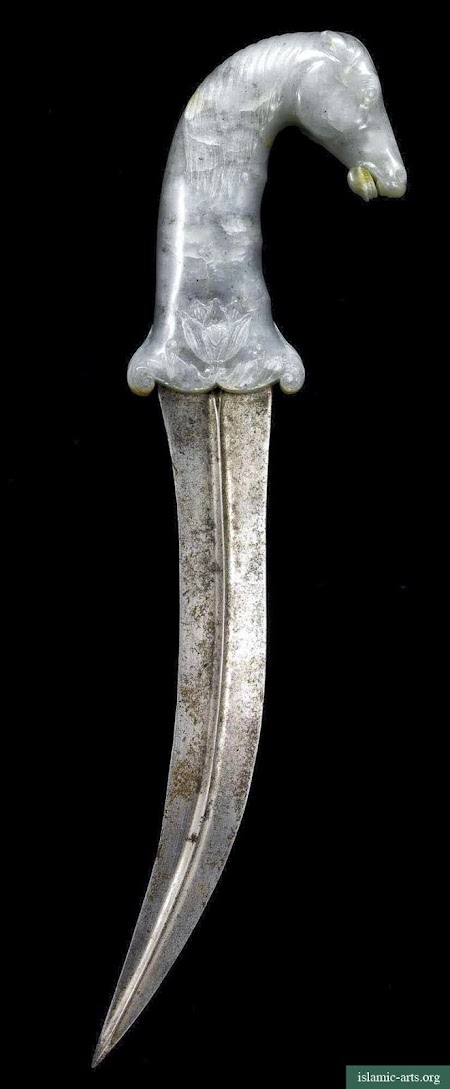
- A MUGHAL HORSE-FORM JADE HILTED DAGGER, INDIA, 18TH-19TH CENTURY
The curved double-edged steel blade
with central ridge, the hilt of pale green stone carved at the forte
with scroll quillons and lotus flower, the pommel rendered in the form
of a horse’s head.
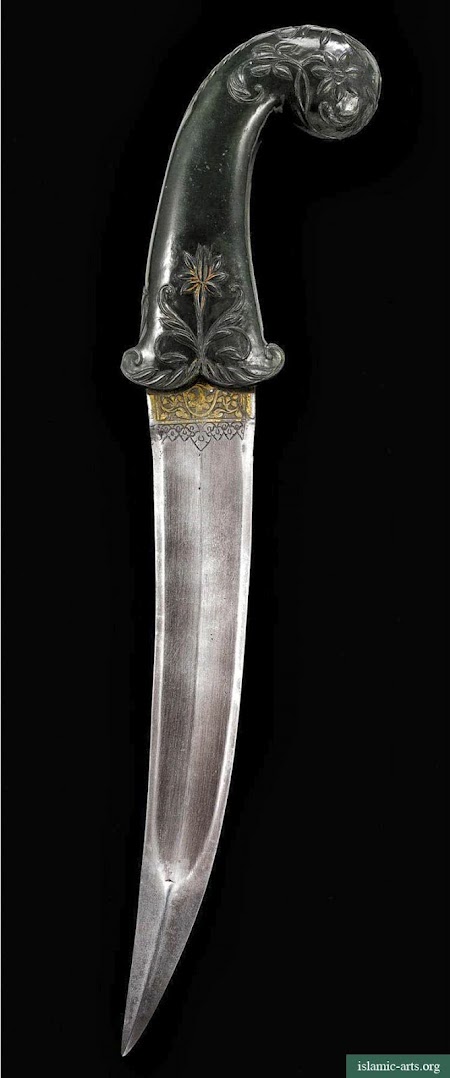
- A MUGHAL JADE-HILTED DAGGER, INDIA, 18TH CENTURY
The slightly curved double-edged
watered steel blade with central ridge, engraved floral motif at the
forte, the jade pistol-grip of dark green stone carved at the forte with scroll quillons and lotus flower, the rounded pommel carved with stylised floral motif.

- AN IVORY-HILTED DAGGER (KHANJARLI) AND SILVER SCABBARD, SOUTH INDIA, EARLY 18TH CENTURY
The curved double-edged watered-steel
blade chiselled with central ridge and yalis flanking the forte, curved
steel knuckle guard terminating in a dragon’s head, ivory hilt
in four parts secured with gold rosette pins terminating in a
bifurcated pommel, the silver scabbard engraved with designs of scrolling vegetation, birds and stylised flowers, with bud finial.
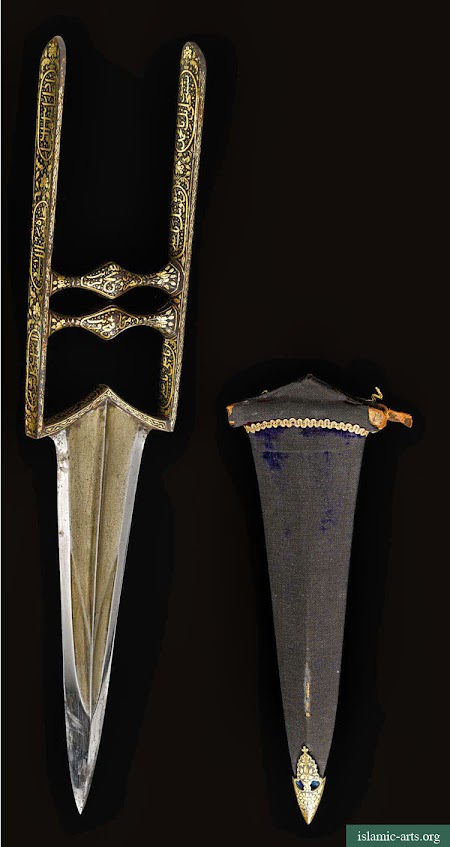
- A KOFTGARI KATAR AND SCABBARD, INDIA, CIRCA 18TH CENTURY
The steel blade fullered with swollen
tip, hilt with double grip and decorated throughout with gold overlaid
inscriptions and floral motifs, the scabbard with chape decorated ensuite.
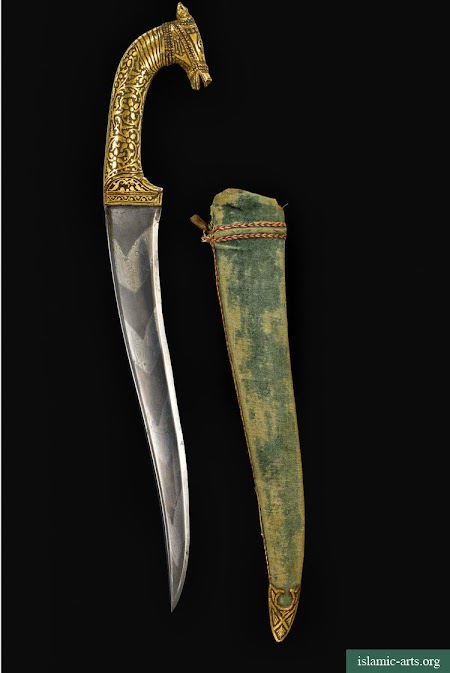
- A KOFTGARI HORSE-HEAD DAGGER AND SCABBARD, INDIA, 19TH CENTURY
The slightly curved watered-steel blade
with chevron design and flat back edge, the pommel carved in the form of
a horse’s head with stylised foliage gold overlay, the velvet-covered
wood scabbard with gold overlay chape.
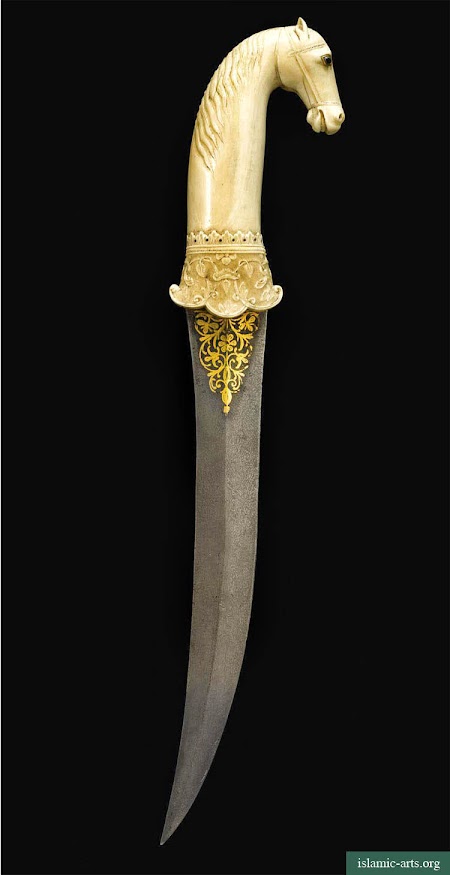
- A RARE IVORY-HILTED HORSE HEAD DAGGER, INDIA, 18TH CENTURY
The slightly curved double-edged watered-steel blade with a faint
central ridge, gold overlay at the forte with floral motifs, ivory hilt
with floral carvings at the forte, pommel set with turquoise stone and in the form of a horse’s head, with eyes set with stones inlaid with gold.
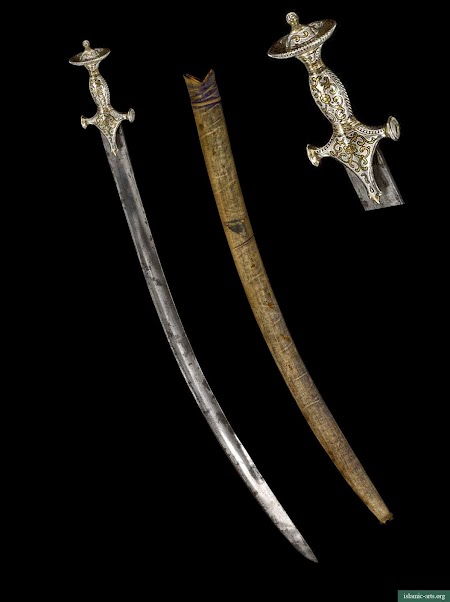
- A RARE HORSE-HILTED DAGGER AND RELATED TALWAR AND SCABBARD, INDIA, 18TH-19TH CENTURY.
The curved tapering steel blade with
central ridge, the hilt with scroll quillons and pommel rendered in the
form of a horse’s head with mane to one side and bridle,
chiselled and decorated with an all over design of gold scrolling vine
issuing flowerheads and split-palmettes against a silver ground; the
slightly curved steel blade with flat back edge, short cross quillons
and hilt in characteristic talwar form wholly inlaid in gold and silver
with chevron pattern and vegetal motifs, the fabric covered wood scabbard.
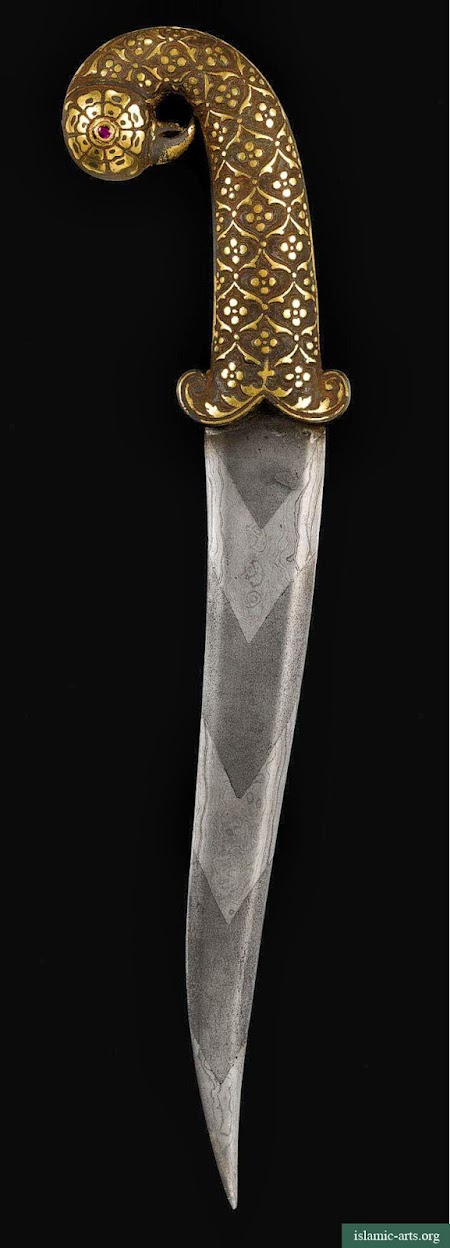
- AN INDIAN STEEL-HILTED DAGGER, 18TH-19TH CENTURY
The
double-edged tapering steel blade with a chevron watered pattern, the
hilt with scroll quillons and rounded pommel rendered in the form of a peacock’s
head, the eyes set with spinnels encircled by a radial lotus design,
the grip chiselled and gilded with a lattice of quatrefoils.
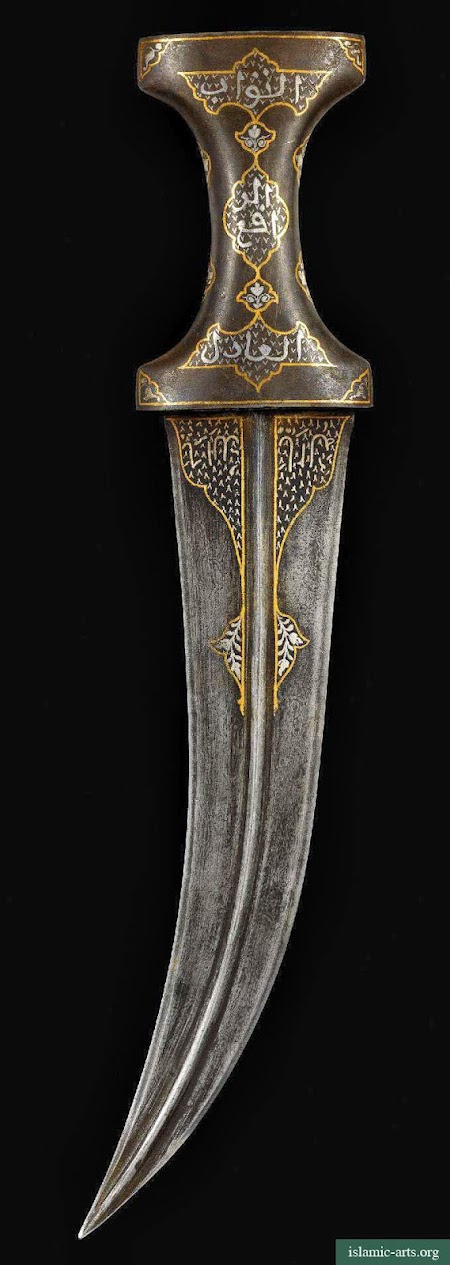
- AN INDIAN STEEL-HILTED DAGGER, 18TH-19TH CENTURY
The watered-steel blade curved at the tip, with central ridge and
gold and silver overlay inscriptions in cartouches split between blade
ridge, the steel hilt with similar gold and silver overlay inscriptions in lobed cartouches flanked by smaller cartouches with floral motifs.

- AN IVORY-HILTED DAGGER (PESHKABZ) WITH SILVER-MOUNTED SCABBARD, INDIA, 18TH-19TH CENTURY
The curved watered-steel blade with
central ridge, double-edged towards the swelled tip, decorated at the
forte with gold-overlaid naturalistic flowers with vase motif, the flat
back edge with stylised palmette and two lobed cartouches containing
inscriptions, ivory hilt in two sections, leather-covered wood scabbard
with applied silver lock and chape, carved throughout with rosettes,
foliate and fishscale designs with bud form terminal.
inscriptions on the back of the blade to the forte:
qabzah-ye khanjar jahangir ast garcheh yak-mosht ostokhan bashad
‘The hilt of [this] dagger conquers the world even though it is [made of] a handful of bones.’

- A FINE IVORY-HILTED DAGGER (KARD) WITH SILVER SCABBARD, BUKHARA, PERSIA, DATED A.H. 1210/ A.D. 1795-6
The
tapered watered-steel blade with chiselled and gold-overlaid
inscriptions, the marine ivory hilt with a cuff of turquoise glass
insets, the silver-gilt scabbard chased with foliate motifs and set with
turquoise.
inscriptions:
Dated ‘In the year 1210 (AD 1795-6)’
The inscriptions include Qur’an, surah al-Saff (LXI), parts of 13; surah Hud (XI), parts of 88; surah Al ‘Imran (III) parts of 126 and invocations to God.
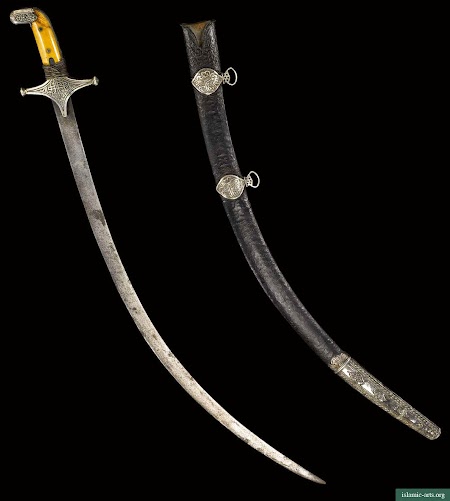
- A SILVER MOUNTED SWORD WITH IVORY GRIPS AND SCABBARD, OMAN, EARLY 19TH CENTURY
The
curved steel blade with inscription in gold overlay at forte, the cross
quillons with punched ground silver and inscriptions and twisted metal
band connecting to ivory hilt with engraved silver pommel comprising
floral motifs, patterned-leather covered wooden scabbard with ensuite
punched ground silver chape and suspension mounts with rings.

- A QAJAR AXE WITH DRAGON FINIALS, PERSIA, 19TH CENTURY
The
blade of crescent form with carved animal motif, and gold overlay
vegetal design, inscription within lobed cartouche and studded with
turquoise stones, with elongated dragon finials and spike, pattern-welded faceted steel haft incised at base and blade.
inscriptions:
Qur’an, surah al-Fath (XLVIII),1 and surah al-Saff (LXI), parts of 13.

- AN OTTOMAN AXE, TURKEY, CIRCA 18TH CENTURY
The blade of characteristic form with silver overlay abstract motif, the haft with ensuite engraved silver panels.
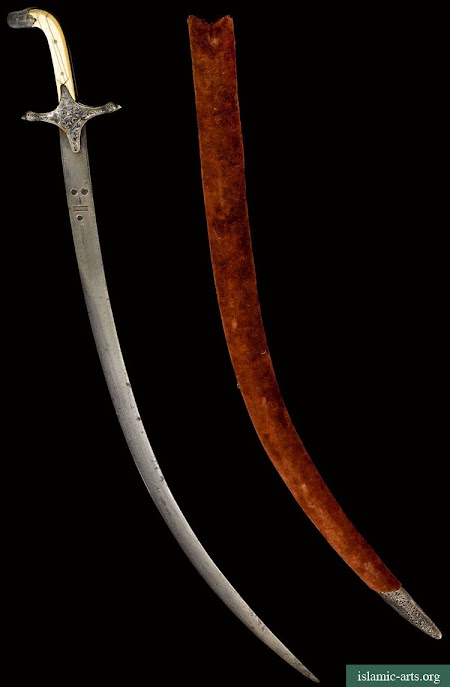
- A RARE SIGNED ARAB WATERED-STEEL BLADE, SYRIA,
16TH CENTURY, WITH INDIAN SILVER ENAMELLED SCABBARD AND HILT, LUCKNOW,
18TH-19TH CENTURY
The curved finely watered-steel blade
with three circular impressions framing inscriptions in cartouches on
both sides of the blade, the later addition of the silver
enamelled quillons in form of bird heads set with rubies and engraved
with animal scenes, the ivory hilt with restored pommel, fabric covered wooden scabbard with openwork chape comprising stylised floral motif.
inscription:
Signed as: ‘Work of His (God’s) servant Sajjad ibn Haji’

- AN ARABIAN SILVER-HILTED SWORD AND SCABBARD, 19TH CENTURY
The
slightly curved steel blade swelling somewhat at the tip with groove at
flat edge, the hooked silver pommel with short quillons and knuckle
chain, the scabbard with ornate openwork silver comprising six rosette medallions, two suspension rings and thread strap.

- A MOTHER-OF-PEARL HILTED SWORD (SHAMSHIR) WITH SCABBARD, INDIA, LATE 18TH CENTURY
The curved and finely watered-steel
blade with gold-overlaid inscriptions in lobed cartouches eitherside of
blade, the hilt quillons and pommel decorated throughout with
dense gold-overlaid floral motifs, the mother-of-pearl hilt comprising
four gold-set red gemstones, the velvet-covered wooden scabbard with ensuite suspension mounts and chape.
inscriptions:
The inscription (spurious) reads: ‘Regnal year 30 of Shah Aurangzeb (‘Alamgir’) and an Arabic saying.
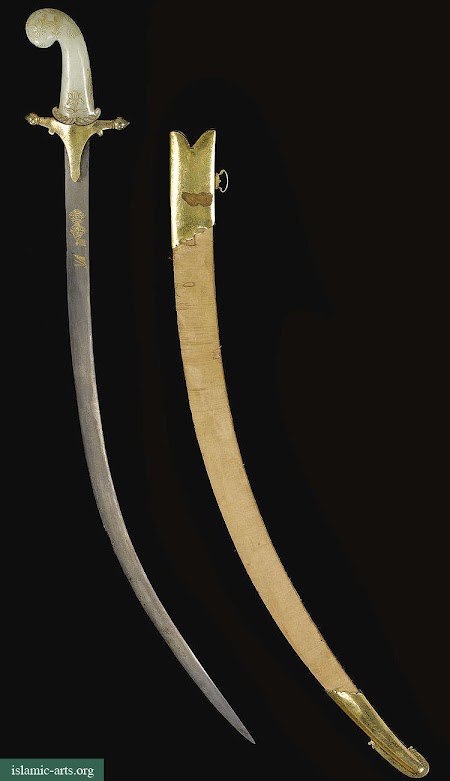
- A MUGHAL JADE-HILTED SWORD WITH GILT-MOUNTED SCABBARD, INDIA, 17TH CENTURY AND LATER
The slender and slightly curved blade
of watered-steel with gold inlaid inscriptions in lobed cartouches and a
talismanic square at the forte, the lightgreenjade hilt with rounded
pommel carved with stylised floral motifs and copper quillons engraved
with fine floral pattern, the cloth-covered wood scabbard with engraved
copper ensuite chape and lock, with one suspension loop.
NOTE: This and the
following sword are from a rare group of jade-hilted swords, only a few
recorded examples exist including an early seventeenth-century talwar
from a private Danish collection published in Copenhagen 1982, p.190
no.154 and an early eighteenth-century jewelled and gold inlaid
jade-hilted sword that also by repute comes from the Hyderabad Treasury,
(illustrated in Ricketts and Missillier 1988, p.102, no.167). The form
of the hilt with the typical rounded pommel and carved floral decoration
is more commonly associated with contemporary jade-hilted daggers. The
only other recorded sword with a jade pistol-hilt is the sword presented
to General Claude Martin in 1786 by the Nawab Asaf-ud-Daula, now in the
Heeramaneck Collection.
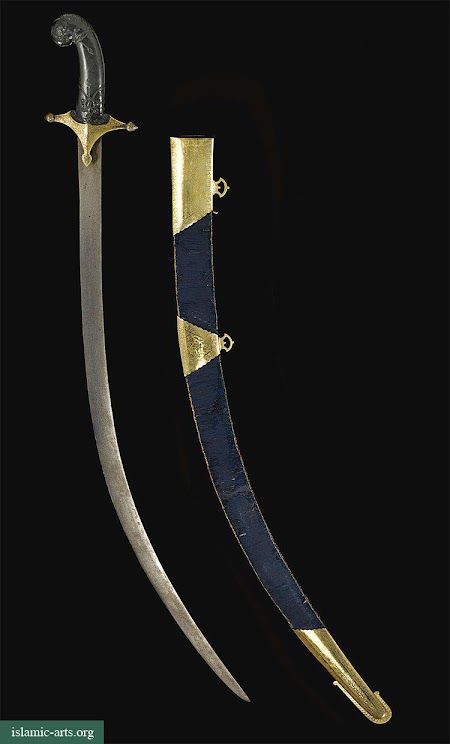
- A MUGHAL JADE-HILTED SWORD WITH GILT-MOUNTED SCABBARD, INDIA, 17TH CENTURY AND LATER
The slender and curved blade of
watered-steel, the dark-green jade hilt with rounded pommel carved with
stylised lotus flowers and copper quillons engraved with fine floral
pattern, the cloth-covered wood scabbard with engraved copper ensuite
chape, lock and suspension bracket.

- A JEWELLED SWORD TALWAR, RAJASTHAN, INDIA, EARLY 19TH CENTURY
The slightly curved steel blade with
raised edge and fullers struck at forte with three talismanic dots on
either side, the gilded-silver hilt with
characteristic broad pommel and hemispherical quillon terminals,
wholly embellished in green and blue enamel and set with thirty-three
gems
including rubies and white sapphires, devanagari inscription to flat
edge of blade at forte, velvet-covered wood scabbard with later
addition of gilt braid.
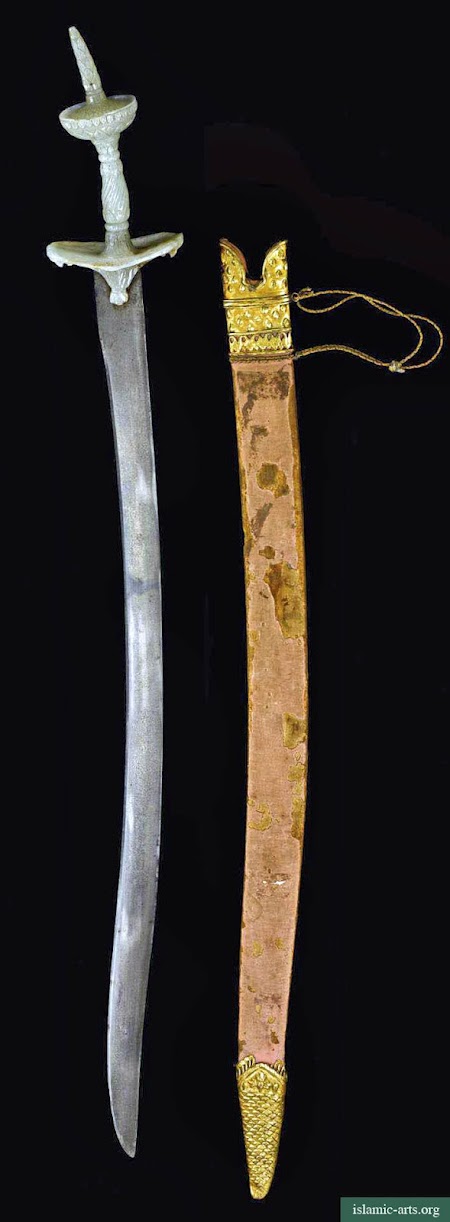
- A FINE AND EXCEPTIONALLY RARE JADE-HILTED TALWAR, INDIA, 17TH CENTURY
The slightly curved finely-watered
steel blade with jade hilt of light-green colour carved exquisitely in
the form of budding lotus flower with a narrow grip, disc pommel and
broad basket guard, the cloth-covered wood scabbard with ensuite gold
repoussé chape and lock decorated with elephant, camel and deers in
procession, scale-patterning and palmette arcades.
This talwar is from a small group of
jade-hilted swords. This form of hilt executed in jade is rare and to
the best of our knowledge unique. Towards the end of the seventeenth
century, Indian craftsmen began to carve hilts with sculpted floral
forms. Under Shah Jahan (r. 1628-58) the quality of jade carving
attained extraordinary heights; works of this period, many of them
carved from white nephrite, are characterised by the organic floral and
vegetal decoration of the late Jahangir period, applied with even
greater elegance and technical perfection. A similar design of lotus
leaf carving contemporary to this hilt can be found on the covered
potiche in the British Museum. The neck is delicately decorated with
overlapping lotus petals carved in relief (see The Indian Heritage:
Court Life and Arts under Mughal Rule, V & A, 1982, p.120, no. 360).
The finely watered-steel blade demonstrates an extremely complex
Damascus pattern including wavy and motley lines, random circular
distortions as well as multiple rudimentary vertical orientations
suggestive of the Kirk Narduban configuration.
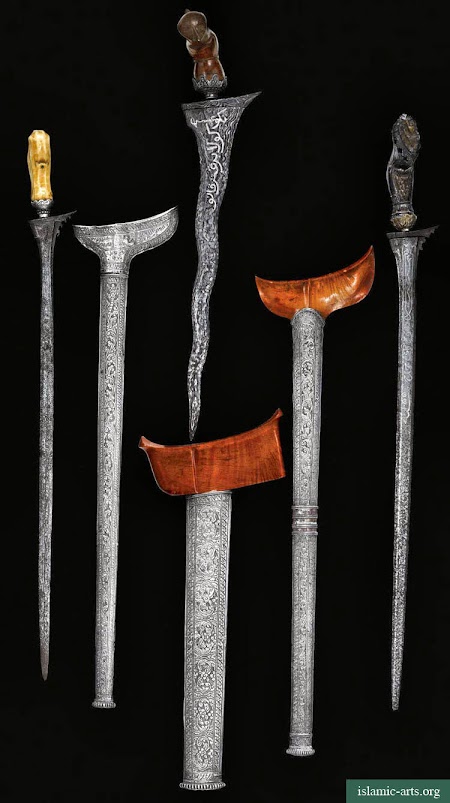
- THREE MALAY DAGGERS (KRIS) WITH SILVER SCABBARDS, MALAYSIA/SUMATRA, 18TH-19TH CENTURY
The wavy-edge layered steel blade,
inscription inlaid with silver at assymetric forte, the wooden hilt in
the form of an abstract bird carving, the silver scabbard with engraved
floral motif and wooden scabbard mouthpiece; the slender double-edged
steel blade with jagged assymetric forte, the faceted ivory hilt,
engraved silver scabbard with inscriptions and floral forms; the slender
double-edged steel blade with jagged assymetric forte and inscriptions
on both sides of blade, the intricately carved wooden hilt with
openwork, in the shape of a stylised flower.
inscriptions:
1) On one side: The Bismalah. On the other side: Undeciphered. Not Arabic, Persian or Turkish.
2) The shahada followed by a quotation, which appears 3 times in the
Qur’an. (Qur’an, surah Al-’Imran (III), parts of 185; surah al-Anbiya
(XXI), parts of 35 and surah al-’Ankabut (XXIX), parts of 57.
An undeciphered inscription and ‘Raj Fatima 1[2]78 (?) (A.D.1861-2)’ ‘Raj Fatima’ is also at the end of the scabbard.
3) Undeciphered inscription with date
as: ‘Year 1155 (A.D.1742-3). The Malay kris became a weapon that above
all was an insignium of rank rather than a practical weapon, and varied
greatly in its embellishment. One particular form of kris was used as an
executioner’s weapon. The victim would traditionally be dispatched by a
single downward thrust from the left collar bone, piercing the heart.
This was thought a more noble death than other possible methods, since
little or no blood was shed.

- JAVANESE SWORDS (SUNDANG), INDONESIA, 19TH CENTURY
The double-edged wavy steel blade
with central groove and gilt abstract illustrations, the elaborate forte
with engraved silver bands and asymmetric jagged edge, crosswork silver
at the hilt with carved wooden pommel; the double-edged wavy steel
blade with central groove and gilt abstract illustrations, the
asymmetric jagged edge, metal thread bands alternating with gold gilt
bands across the hilt terminating in a conceptual bird pommel carved of
ivory, with wooden scabbard.

- AN OTTOMAN TOMBAK SWORD (YATAGHAN) AND SCABBARD, TURKEY, LATE 18TH/EARLY 19TH CENTURY
The forward curved steel blade with
flat back edge, gold gilt leaf motif at forte with inscription cartouche
on one side of blade, the gilt copper hilt with fluted pommel, the
fabric covered wooden scabbard with chased engravings on gilt copper
with ensuite chape and lock and bud finial.
inscriptions
Owner’s name as: ‘al-Hajj Sulayman Agha’

- AN OTTOMAN GEM-SET JADE-HILTED DAGGER AND LEATHER SCABBARD, TURKEY, CIRCA 1700
The double-edged double-groove
watered-steel blade with stamped cartouches at the forte, the hilt of
light-green jade set with six gold-mounted red gems, leather-covered
wood scabbard with twisted metal along the length.
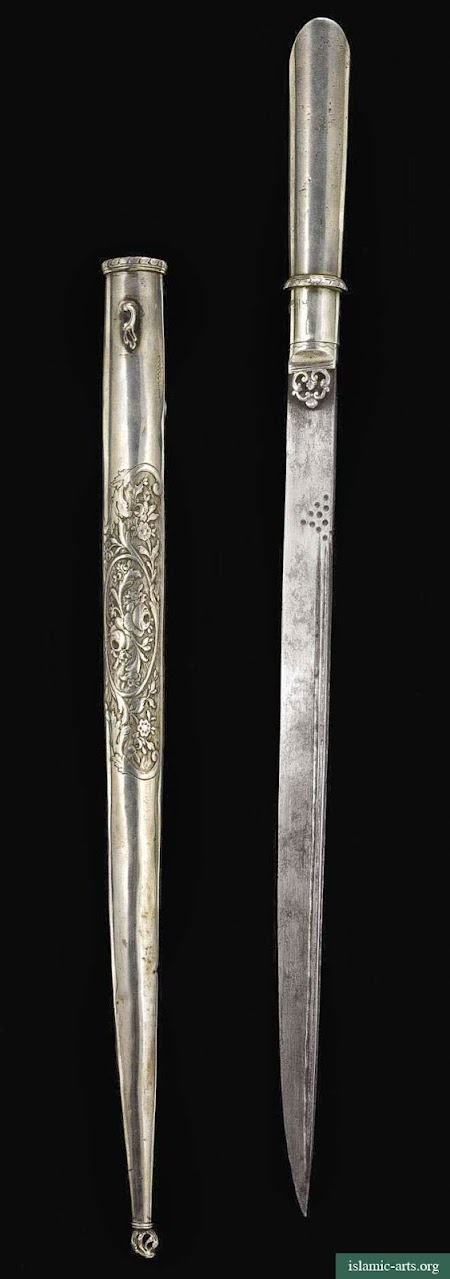
- AN OTTOMAN SILVER DAGGER (KARD) AND SCABBARD, TURKEY, PERIOD OF MAHMUD II, CIRCA 1810
the tapered steel blade with flat
back edge, with point design in form of pyramid on either side of blade,
the silver hilt with inscription at the forte, silver scabbard with
intricate oval rose design and openwork bud finial.
inscriptions:
Owner’s name as: ‘The owner Adham Afandi’ spelt in Turkish as: ‘Edhem Efendi’
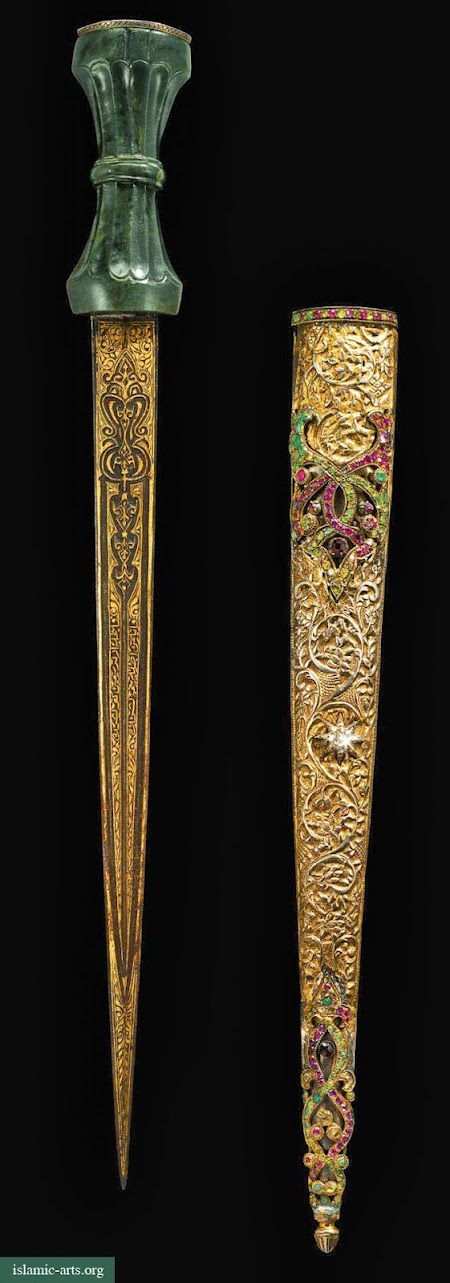
- AN OTTOMAN JADE-HILTED AND GEM-SET DAGGER AND SCABBARD, TURKEY, 19TH CENTURY
The straight steel blade with
central ridge, wholly decorated with gold gilt inscriptions and varied
motifs, the waisted dark-green jade hilt with carved flutes, the pommel
embellished with openwork silver set with gemstones, the engraved silver
scabbard adorned with cabochon and faceted gemstones to one side of the
scabbard.

- AN OTTOMAN IVORY-HILTED SWORD (YATAGHAN) AND SCABBARD, TURKEY, LATE 18TH/EARLY 19TH CENTURY
The slightly curved steel blade
wholly decorated with gold overlay floral motifs and central cartouche
comprising inscription to one side of blade with flanking smaller
cartouches and inscriptions, the ivory hilt with characteristic yataghan
pommel, leather covered wooden scabbard tooled with cartouches, ensuite
gilt copper chape and lock with abstract band design at lock and finial
in form of a makara.
inscriptions:
Signed as: ‘Work of Ahmad’.
Owner’s name as: ‘Owner Sayyid Salim Agha’
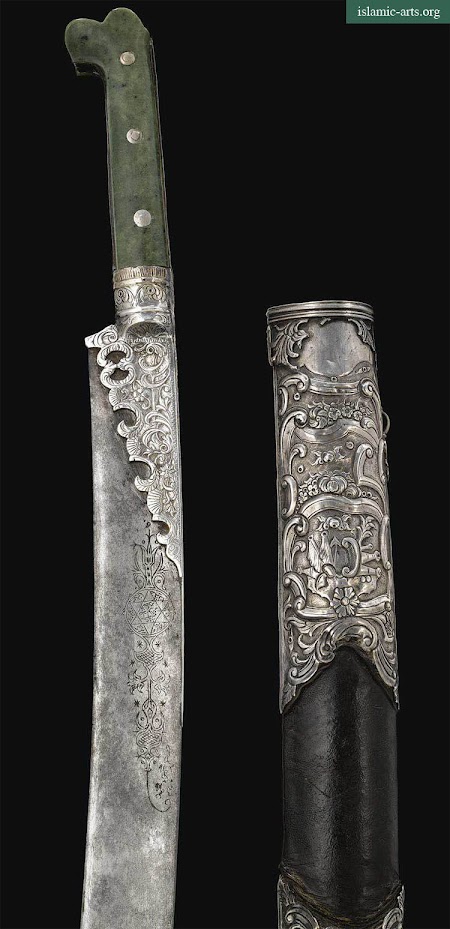
- AN OTTOMAN JADE-HILTED SILVER-MOUNTED SWORD (YATAGHAN) AND SCABBARD, TURKEY, DATED A.H. 1188/ A.D. 1774-5
The slightly curved steel blade with
inscriptions in decorative cartouches at the forte, carved silver hilt
extending over the forte, the marbled-jade hilt secured by six
silver pins, the leather covered wooden scabbard with intricately
engraved ensuite chape and lock with bud finial.
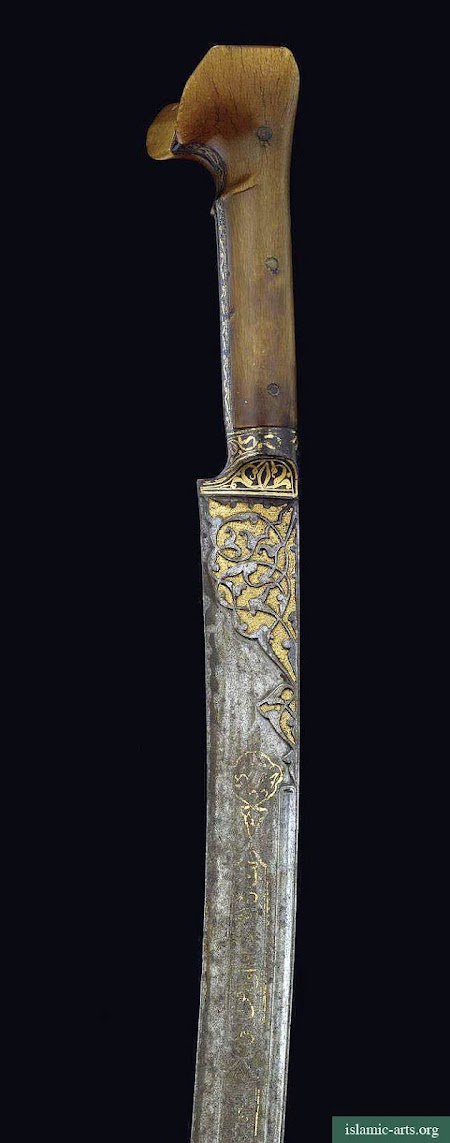
- A RARE OTTOMAN RHINOHORN-HILTED YATAGHAN, TURKEY, 18TH CENTURY
The slightly curved steel blade with
flat back edge, carved with floral motif at the forte, the rhinohorn
hilt with a shim comprising gold gilt band decoration, with vestiges of
gilt inscriptions along both sides of the blade.
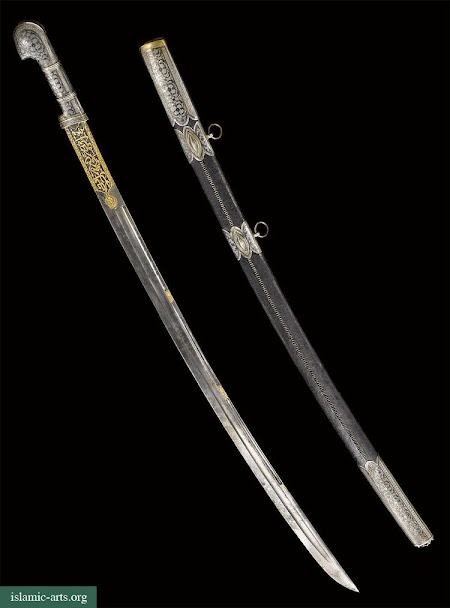
- A SILVER-MOUNTED NIELLOED SWORD AND SCABBARD, CAUCASUS, 19TH CENTURY.
The slightly curved steel blade with
deep groove at flat edge of blade adorned by gold overlay, large carved
inscription to one side of blade with bird and smaller inscription in a
lobed cartouche to the other with lion, the nielloed hilt with a split
pommel, the leather-covered wood scabbard with nielloed ensuite chape,
lock and two suspension mounts with rings.

- A RARE MARITIME CUTLASS AND SCABBARD, MOROCCO, 17TH/18TH CENTURY BLADE WITH 19TH CENTURY SCABBARD
The steel blade of characteristic
form with copper quillons in assymetric curve and engraved silver mount
at forte comprising floral motif, the faceted rhino-horn hilt with
ribbed-dome finial, wooden scabbard with red-ground velvet and gilt
metal-thread embroidery comprising six-point star and vegetal motif,
with ensuite engraved copper chape and lock with central rectangular
panels comprising floral motifs.
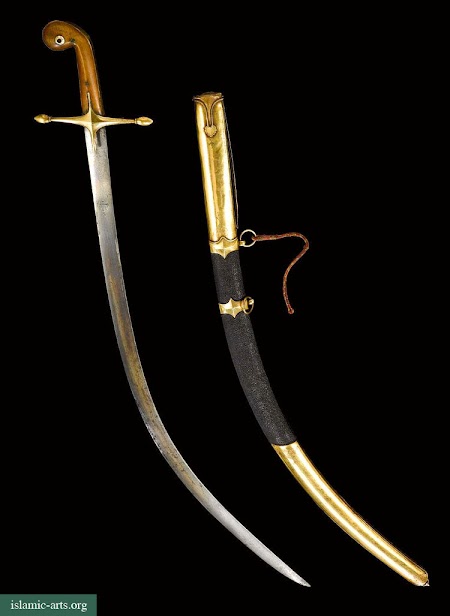
- A FINE OTTOMAN SWORD (SHAMSHIR) WITH GOLD-MOUNTED SCABBARD, TURKEY, 19TH CENTURY
The slender and curved blade of
finely-watered steel with gold inscription in lobed cartouche at the
forte, with gold hilt quillons, horn grip and gold set velvet roundels
at pommel, leather-covered wood scabbard with ensuite engraved gold
chape, lock and suspension mounts with rings.
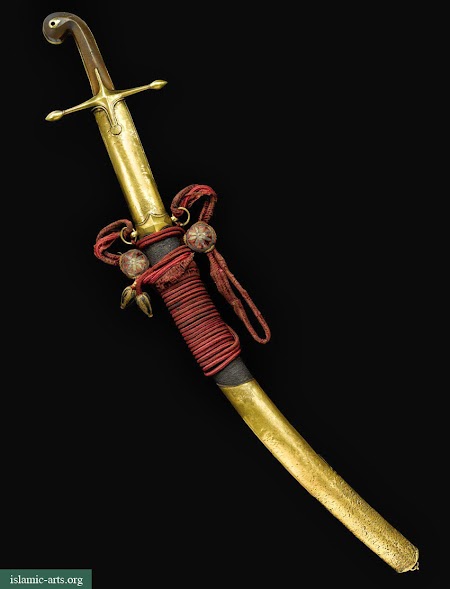
- A RARE OTTOMAN SOLID GOLD-MOUNTED SWORD (KILIJ) AND SCABBARD, TURKEY, 19TH CENTURY
The slightly curved slender steel
blade expanding towards the tip with ridges to the flat edge, solid gold
hilt quillons and rhino horn hilt, leather covered wooden scabbard with
finely engraved solid gold ensuite chape and lock, scabbard with
attached cord and ivory collection label inscribed “Presentation Sword
to Admiral Dundas”.
Remembered as a brave and chivalrous
officer, James Whitley Deans Dundas began his naval career with
expeditions to Holland (1799), Gibralter and Egypt (1800) before serving
as Midshipman at the blockade of Alexandria aboard H.M.S. Kent. He was
promoted to lieutenant aboard the Cambrian in 1805 before being given
command of the Rosamund in 1806. He was injured by a shell explosion in a
Copenhagen dockyard whilst trying to extinguish a fire that had broken
out after the surrender of the city. Following many years service in the
Baltic and North Seas as well as the Mediterranean, Dundas was promoted
to the rank of Rear-Admiral in 1841, and then Vice-Admiral in 1852.
When the Russian war broke out in 1854, Dundas had chief Naval command
of the operations, including the transport of the army to the Crimea and
the engagement with the sea-forts during the Siege of Sevastopol on
17th October of that year. Dundas gained the rank of full Admiral in
1857 after having been awarded the Grand Cross of the Legion of Honour
and the Medjidie of the first class two years previously. He died in
October 1862. His portrait by W.J. Edwards hangs in the National
Portrait Gallery, London.
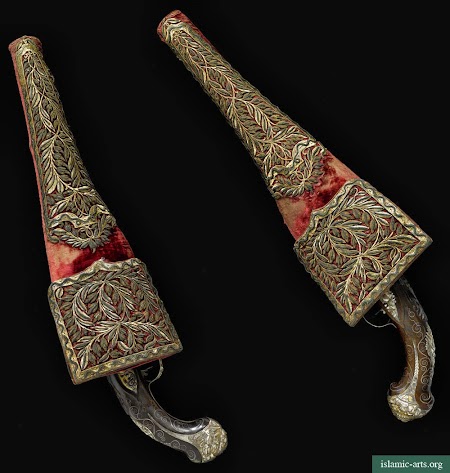
- A PAIR OF OTTOMAN SILVER GILT AND WIRE-INLAID
PISTOLS WITH METAL THREAD-EMBROIDERED SADDLE HOLSTERS, TURKEY OR
BALKANS, 19TH CENTURY
The steel barrels with gold overlay
comprising a turban within a circular garland and star motifs, the
carved forestock with naturalistic floral motif, the stock decorated
throughout with wire-inlaid abstract pattern, the grip, pommel and
trigger guard with carved military instruments, the lockplate inscribed
with ‘H. Vigniat at St Etienne’, both with velvet covered saddle
holsters embroidered with metal-thread vegetal design, with ammunition
pouch under flap.

- AN OTTOMAN PARCEL-GILT SILVER CASED PISTOL, OTTOMAN PROVINCES, CIRCA 1800
The long tapered steel barrel encased
at the muzzle, the stock decorated throughout with gilt-silver, finely
chiselled and chased with floral motifs,
maker’s stamp at the sighting plate, a bulbous pommel and finely carved trigger guard with embossed peacock.

- A FINE OTTOMAN SILVER-MOUNTED PISTOL, TURKEY, CIRCA 1840
The long tapered steel barrel encased by a
silver mount at the muzzle, the stock fully decorated with engraved
silver mounts comprising floral motifs, lock plate with embossed motif
of lions, flintlock engraved and inscribed ‘Herman Ghiot’.
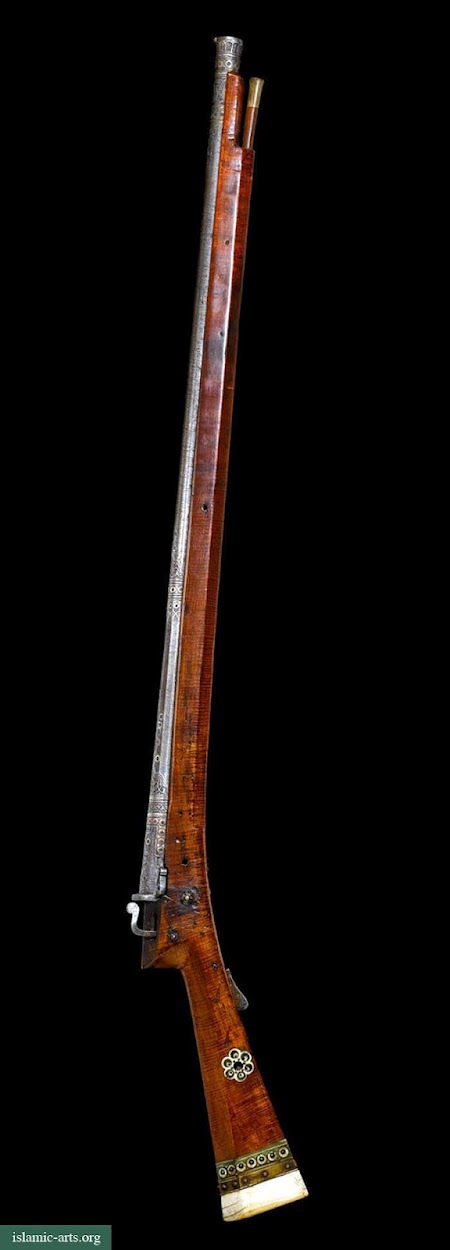
- AN OTTOMAN IVORY-INLAID AND CINTAMANI-DECORATED MATCHLOCK GUN, TURKEY, 17TH CENTURY.
The Kirk-Narduban patterned steel
barrel with carved lobed cartouches, the faceted wooden stock, the
sighting plate and front stock decorated with natural and green-stained
ivory mosaic cartouches and bands, the ivory butt plate.
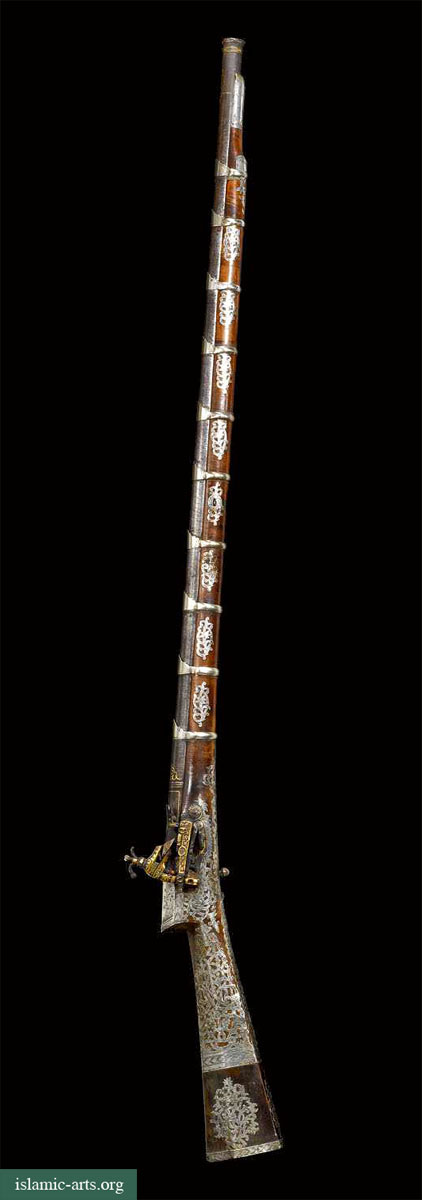
- AN OTTOMAN SILVER-MOUNTED RIFLE, TURKEY, DATED A.H. 1212/ A.D. 1797-8
The slender barrel of cast steel with
gold gilt palmettes at each end of the barrel, silver engravings
comprising floral motifs secured to the whole of the rifle, predominantly at the stock and butt, with a engraved silver sighting plate, gold overlay and coral at the trigger.

- AN OTTOMAN IVORY-INLAID FLINTLOCK GUN, TURKEY, 17TH CENTURY.
The long and slender barrel of
pattern-welded steel with fine floral engravings and inscription, stamp
of horse on steel barrel, ivory-inlaid and khatamkari decoration to the
wooden forestock, with stained-green ivory sighting plate.

- A PERSIAN/CAUCASIAN IVORY-MOUNTED RIFLE, EARLY 19TH CENTURY
The steel barrel wholly decorated
with gold overlay floral motifs, clasped to the forestock by applied
niello mounts, gold overlay to the trigger and trigger plate, niello
band of palmettes at ivory butt plate.
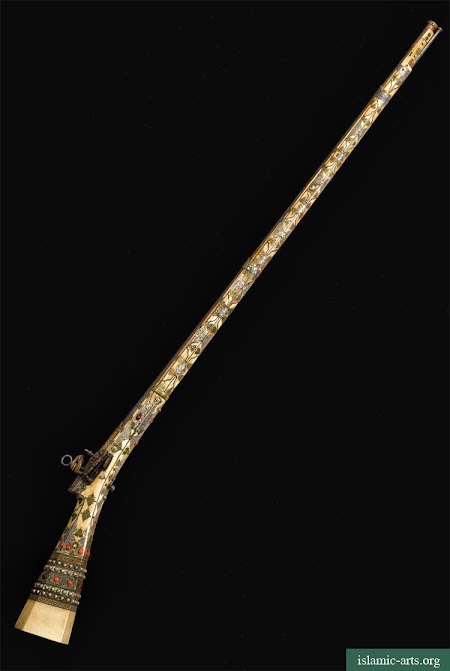
- A RARE OTTOMAN IVORY-MOUNTED RIFLE WITH THE TUGHRA OF MAHMUD I (A.H.1143- 68/ A.D.1730-54), TURKEY, MID-18TH CENTURY
The pattern-welded steel barrel with
gold overlaid lobed cartouches, the wooden stock faced with ivory richly
decorated with inlaid mosaic hexagrams, the stock with teardrop shaped
coral set in bands of engraved silver, a small tughra stamp on the
barrel, the butt plate of replacement ivory.
It is thought that this rare type of
gun bearing white and green-stained ivory decoration was made for the
bodyguard of the Ottoman sultan. Traditionally ascribed to the late
17th/ early 18th century (Paris 1988, no. 42 and 43), a dated example in
the Khalili Collection (d. A.H. 1191 / A.D. 1777-8) suggests that the
whole group should be reassigned to a later period (Alexander 1992,
pp.128-129, no.73). Michael Rogers, however, convincingly points to
documentation that such pieces were certainly manufactured in 17th
century Istanbul: “In his account of Bitlis in 1655-6,
Evliya Celebi gives a list of muskets by the most reputed makers
allegedly in the collection of Abdal Khan, the ruler of that
principality. Among the Istanbul masters, he lists Memi, Kuçuk Omer,
Uzun Mehmed and Kara Mehmed Ketbeli as specialists in jewelling and
encrustation” (Rogers
1995, p.154).
Comparable examples of ivory-inlaid
Ottoman guns are in the Metropolitan Museum of Art, New York (inv. no.
32.75.270), the Military Museum in Istanbul (Palace of Gold and Light,
Washington, 2000, p.160, no.E25), the Victoria & Albert Museum
(North, A., An Introduction to Arms and
Armour, London, 1985, p.11, fig.3b), the Wallace Collection (Laking,
G., Wallace Collection Catalogues: Oriental Arms and Armour, London,
1914, no.2091) and the Khalili Collection in London (Alexander 1992,
pp.126-9, nos.72 and 73; Paris 1988, no.42), as well as two privately
owned in Denmark (Islamic Arms and Armour from Danish Private
Collections, Copenhagen, 1982, nos. 40 and 41) and a number of others.
inscriptions:
Signed as: ‘Work of Mahmud ibn Muhammad’ With the tughra of Mahmud I (A.H. 1143- 68/A.D. 1730-54)
Stamped maker’s name as: ‘Work of Khidr (?) ibn Muhammad’
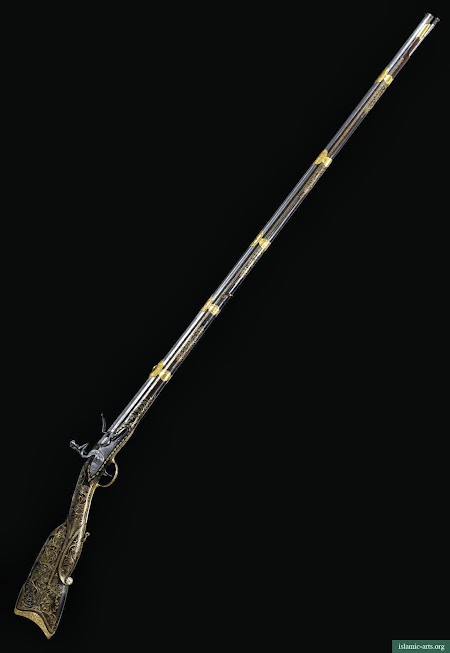
- A FINE OTTOMAN GOLD-INLAID FLINTLOCK RIFLE SIGNED BY THE MASTER ‘UMAR, ITALY AND TURKEY, DATED A.H. [1]263 / A.D. 1846-7
the octagonal watered steel barrel
stamped with the maker’s name PIETRO GATELI and held by five capucines,
the steel lock inscribed BERTELI, the wood stock inlaid with
gold wire with elaborate floral and vegetal scrolls, with the Turkish
maker’s name and date, further enriched by applied gold escutcheons chased with vine scrolls.
inscriptions
Inlaid in gold on the stock:
ya quli (?) usta ‘ umar sana [1]263
“…The master ‘Umar, the year [1]263/(1846-7)”
The rifle is notable for its accomplished and elegant design and the lavish use of gold inlay executed with exceptional elaboration and care. The chased and engraved gold escutcheons are also of refined quality and further enhance the sumptuous effect.

- A RARE EUROPEAN GOLD AND SILVER WIRE-INLAID SPORTING RIFLE FOR THE OTTOMAN MARKET, 19TH CENTURY
The Martini-Henry rifle with
slender barrel of cast steel and wooden sighting plate with gold
wire-inlaid floral motifs, the wood stock and butt plate with silver
wire-inlaid ornamentation, wood butt plate also comprises carving of
military devices.
Martini rifles were supplied to the
Ottoman forces in large numbers. Following the victory of the Prussians
in Europe in 1866, the Ottomans instituted major military reforms
inaugurated by Hussein Avni Pasha in 1869. As a result, in the war
against Russia in 1877-8, Ottoman troops
were armed with Martini Henry and Snider rifles as well as the new metal cartridge which the Russians did not yet possess.






































































0 comments:
Post a Comment